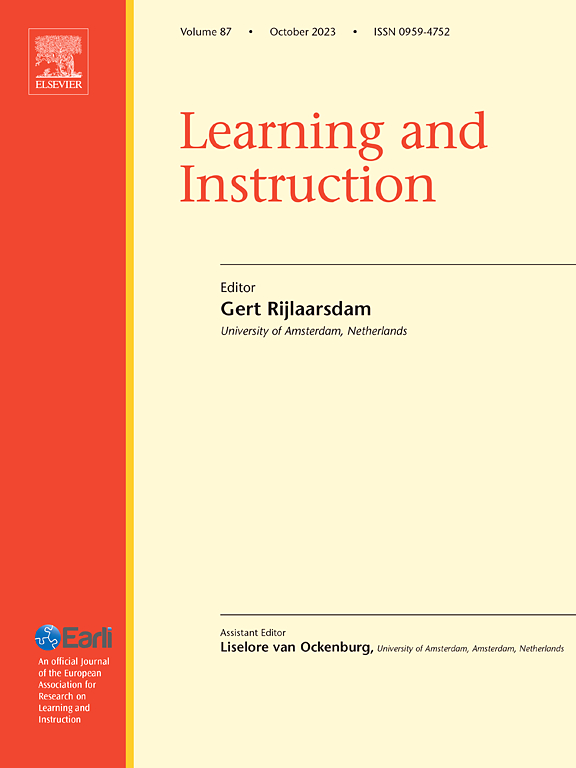The application of the flipped classroom teaching method in periodontal medical education
IF 4.9
1区 教育学
Q1 EDUCATION & EDUCATIONAL RESEARCH
引用次数: 0
Abstract
Background
The flipped classroom approach has emerged as a promising pedagogical model in medical education, enhancing student engagement and learning outcomes. This study investigates its effectiveness in periodontal education, where integrating theoretical knowledge with practical skills is crucial.
Aims
To evaluate the impact of the flipped classroom on learning outcomes, student engagement, and clinical skills in periodontal medical education, and to assess long-term retention.
Sample
Sixty-three students from the School of Stomatology, XXX University, were randomly assigned to an experimental group (EG, n = 31) or a control group (CG, n = 32), with comparable demographic characteristics.
Method
The EG adopted a role-flipped model where students led class discussions after self-directed preparation, while the CG received teacher-centered lectures and both groups had access to identical pre-class materials. Both groups participated in theoretical classes, practical classes and clinical internships. Two years later, preclinical practice scores were collected to evaluate long-term impact. Data analysis was conducted using SPSS version 25.0 and employing MANOVA to compare performance metrics between the two groups.
Results
The EG outperformed the CG in clinical skills, class tests, and medical record writing (p < 0.05), with significantly higher final exam scores (p < 0.05). Long-term follow-up showed sustained superior skills in the EG (p < 0.05).
Conclusions
The flipped classroom approach significantly enhanced learning outcomes and clinical skills in periodontal education, fostering essential competencies. These findings advocated for the adoption of this model in medical education, particularly in specialized fields requiring both theoretical understanding and practical expertise.
翻转课堂教学法在牙周医学教育中的应用
背景:在医学教育中,翻转课堂教学法已经成为一种很有前途的教学模式,可以提高学生的参与度和学习成果。本研究探讨了其在牙周教育中的有效性,将理论知识与实践技能相结合是至关重要的。目的评估翻转课堂对牙周医学教育的学习效果、学生参与度和临床技能的影响,并评估长期保留情况。来自XXX大学口腔医学院的63名学生被随机分为实验组(EG, n = 31)和对照组(CG, n = 32),两组人口统计学特征相当。方法EG组采用角色翻转模式,学生在自主准备后主导课堂讨论,CG组接受以教师为中心的授课,两组使用相同的课前材料。两组均参加理论课、实践课和临床实习。两年后,收集临床前实践评分来评估长期影响。数据分析采用SPSS 25.0版本,采用方差分析比较两组之间的绩效指标。结果EG组在临床技能、班级测试、病案书写等方面优于CG组(p <;0.05),期末考试成绩显著提高(p <;0.05)。长期随访显示在EG方面持续的优势技能(p <;0.05)。结论翻转课堂教学能显著提高牙周教育的学习效果和临床技能,培养学生的基本能力。这些发现提倡在医学教育中采用这种模式,特别是在既需要理论认识又需要实践专门知识的专业领域。
本文章由计算机程序翻译,如有差异,请以英文原文为准。
求助全文
约1分钟内获得全文
求助全文
来源期刊

Learning and Instruction
Multiple-
CiteScore
11.30
自引率
4.80%
发文量
109
期刊介绍:
As an international, multi-disciplinary, peer-refereed journal, Learning and Instruction provides a platform for the publication of the most advanced scientific research in the areas of learning, development, instruction and teaching. The journal welcomes original empirical investigations. The papers may represent a variety of theoretical perspectives and different methodological approaches. They may refer to any age level, from infants to adults and to a diversity of learning and instructional settings, from laboratory experiments to field studies. The major criteria in the review and the selection process concern the significance of the contribution to the area of learning and instruction, and the rigor of the study.
 求助内容:
求助内容: 应助结果提醒方式:
应助结果提醒方式:


